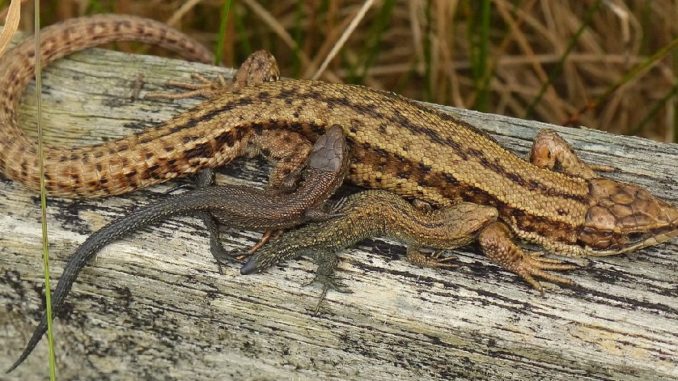
The answer is both. Some lizards lay eggs while others give birth like we do. There are even species that can actually change from laying eggs to giving birth, according to their environment. And for the very first time, researchers in Australia have found a lizard that switched from eggs to giving birth at the same time, recently.
Lizards Reproduction: So Many Different Ways to Give Birth
You might think that lizards’ reproduction is a boring subject, but you’d be quite wrong. It is one of the most fascinating of all living species. Why? Because there are so many ways it can happen. Did you know that the female Komodo dragon can actually make herself pregnant without a male around? There is no better example in the world than this for the need of survival of a species. And if there are males to mate with, then she will procreate normally.
Some lizards will always lay eggs, and others will only give birth. In the first category, we find geckos, iguanas as well as monitor lizards. In the second one, blue tongue lizards, Solomon island lizards and shingle-back lizards are names you may have heard of. And then you have the three-toed skink, which is a lizard that looks more like a snake, who just recently gave birth by laying eggs and giving live birth at the same time.
Eggs or Live Birth?
It usually takes a male and a female lizard coupling for the female to lay eggs or give birth. But as we saw earlier, there are exceptions to the rule. In fact, there are more different ways to handle reproductions in lizards than a general rule. Some of them will lay eggs after mating, in a safe place, and just move on with their lives, while others will give birth to them and also let them grow by themselves.
You may wonder why that is. In fact, it is a question that civilisation has been asking itself for millenniums: “Which came first? The baby or the egg?” The answer is: The egg. A study of a variety in lizards in Australia has helped understanding that giving live birth came after laying eggs. It is part of evolution. Giving live birth provides many advantages over laying eggs and that is why some species of lizards have now moved on to live birth while others, less evolved, still lay eggs.
Differences in All Respects of Procreation
The differences in lizards’ procreation cycles can be found in much more than just eggs or live birth. Like most animals, lizards have a breeding season. However, it varies a lot from one species to another. It can be a seasonal thing for some, while it is based around specific circumstances for others.
When it comes to laying eggs, there is no specific number of laid eggs either. Some can deliver a dozen at a time and others only one. Normally, the incubation process leading to hatching takes place openly in the wild, and there is no way to know how many offspring will actually see the light of day at the end of the period.
Evolution at Work
Evolution is not just a theory and we can see it clearly at work in Australia with the three-toed skink, formally known as Saiphos equalis. Scientists have recently witnessed a female laying eggs and giving live birth in one time. That is a first for any reptile species. They already knew that the skink was capable of both laying eggs or giving live birth, but the surprise was total when they observed the birth process and saw both happening at once.
As we explained before, it is evolution that has seen some lizard species move on from laying eggs to giving live birth. In fact, more than 150 species are known to have done so to this day. Scientists assume that they have witnessed something very unique, which is the process of evolution of a species. It is what would explain, according to them, the fact that both processes were observed.
A Weather Based Phenomenon
Some of the scientists are still unsure of the evolution pattern, saying that in some instances laying eggs still remain a safer way for offspring to come to life. To them, there are no reasons why this process would change in the years to come. In fact, research has shown that this particular species will use either method depending on the climate. In the warmer parts of the country, the three-toed skinks will generally lay eggs while in colder regions they will give live birth.
That is part of the evolution theory, not just for lizards. It is called the “cold-climate hypothesis” which states that live-bearing might be advantageous in cooler climates. But there is still so much that we don’t know about the biology of these lizards, it is hard to confirm that this is what specifically determines the type of birth at all times.

Leave a Reply